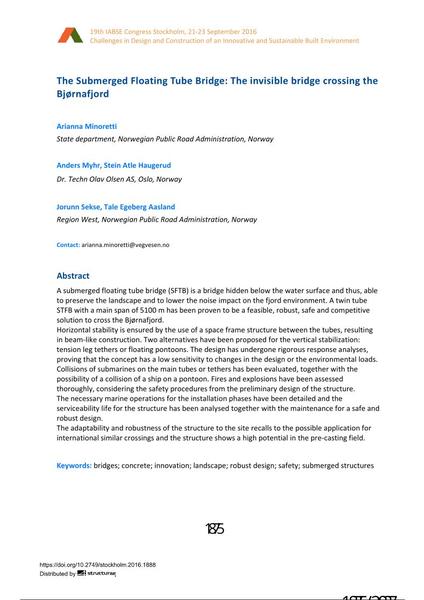The Submerged Floating Tube Bridge: The invisible bridge crossing the Bjørnafjord

|
|
|||||||||||
Bibliographic Details
| Author(s): |
Arianna Minoretti
(State department, Norwegian Public Road Administration, Norway)
Anders Myhr (Dr. Techn Olav Olsen AS, Oslo, Norway) Stein Atle Haugerud (Dr. Techn Olav Olsen AS, Oslo, Norway) Jorunn Sekse (Region West, Norwegian Public Road Administration, Norway) Tale Fjell Egeberg (Region West, Norwegian Public Road Administration, Norway) |
||||
|---|---|---|---|---|---|
| Medium: | conference paper | ||||
| Language(s): | English | ||||
| Conference: | IABSE Congress: Challenges in Design and Construction of an Innovative and Sustainable Built Environment, Stockholm, Sweden, 21-23 September 2016 | ||||
| Published in: | IABSE Congress Stockholm, 2016 | ||||
|
|||||
| Page(s): | 1875-1882 | ||||
| Total no. of pages: | 8 | ||||
| Year: | 2016 | ||||
| DOI: | 10.2749/stockholm.2016.1888 | ||||
| Abstract: |
A submerged floating tube bridge (SFTB) is a bridge hidden below the water surface and thus, able to preserve the landscape and to lower the noise impact on the fjord environment. A twin tube STFB with a main span of 5100 m has been proven to be a feasible, robust, safe and competitive solution to cross the Bjørnafjord. Horizontal stability is ensured by the use of a space frame structure between the tubes, resulting in beam-like construction. Two alternatives have been proposed for the vertical stabilization: tension leg tethers or floating pontoons. The design has undergone rigorous response analyses, proving that the concept has a low sensitivity to changes in the design or the environmental loads. Collisions of submarines on the main tubes or tethers has been evaluated, together with the possibility of a collision of a ship on a pontoon. Fires and explosions have been assessed thoroughly, considering the safety procedures from the preliminary design of the structure. The necessary marine operations for the installation phases have been detailed and the serviceability life for the structure has been analysed together with the maintenance for a safe and robust design. The adaptability and robustness of the structure to the site recalls to the possible application for international similar crossings and the structure shows a high potential in the pre-casting field. |
||||
| Keywords: |
concrete bridges safety landscape innovation submerged structures robust design
|
||||

